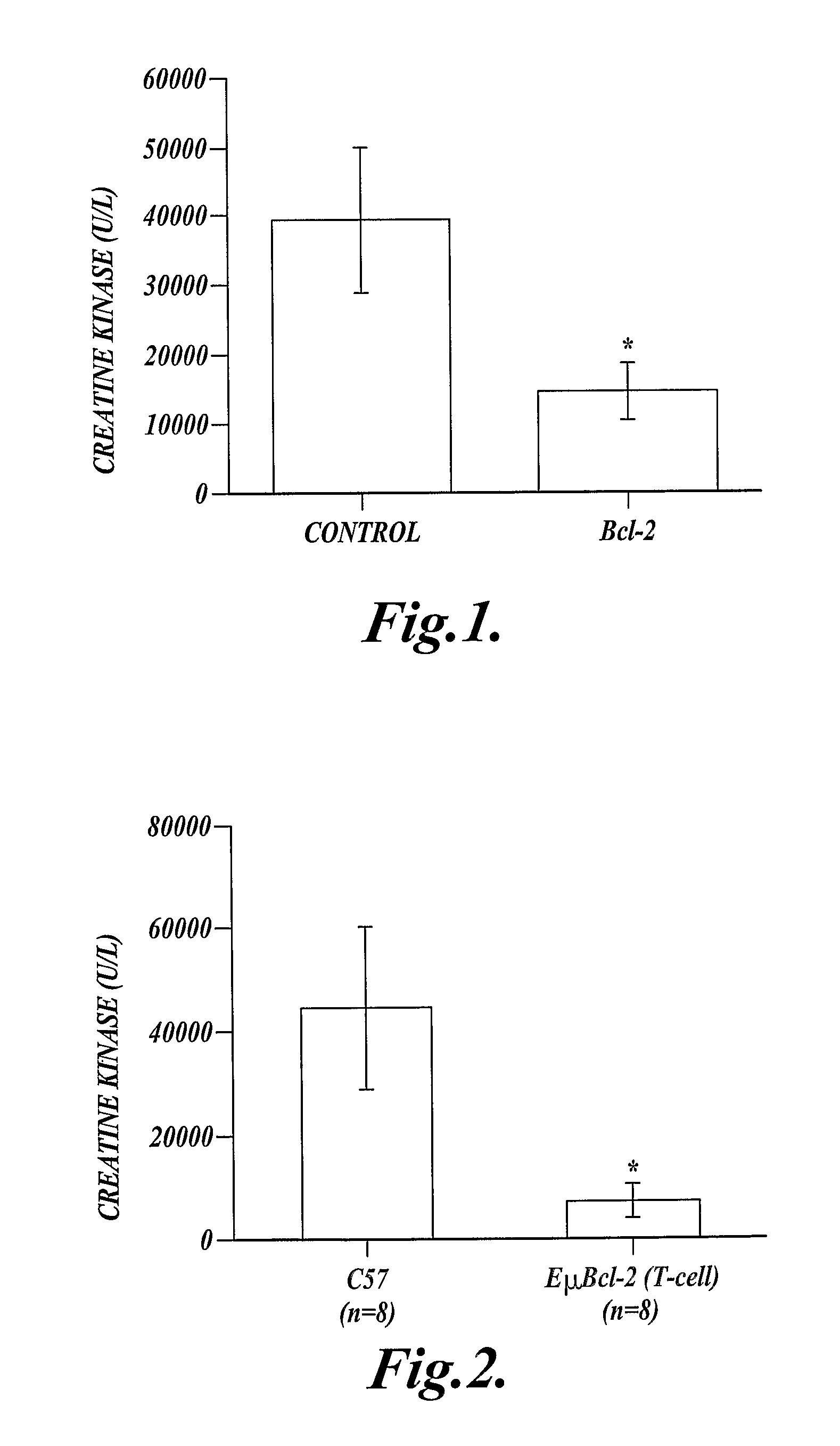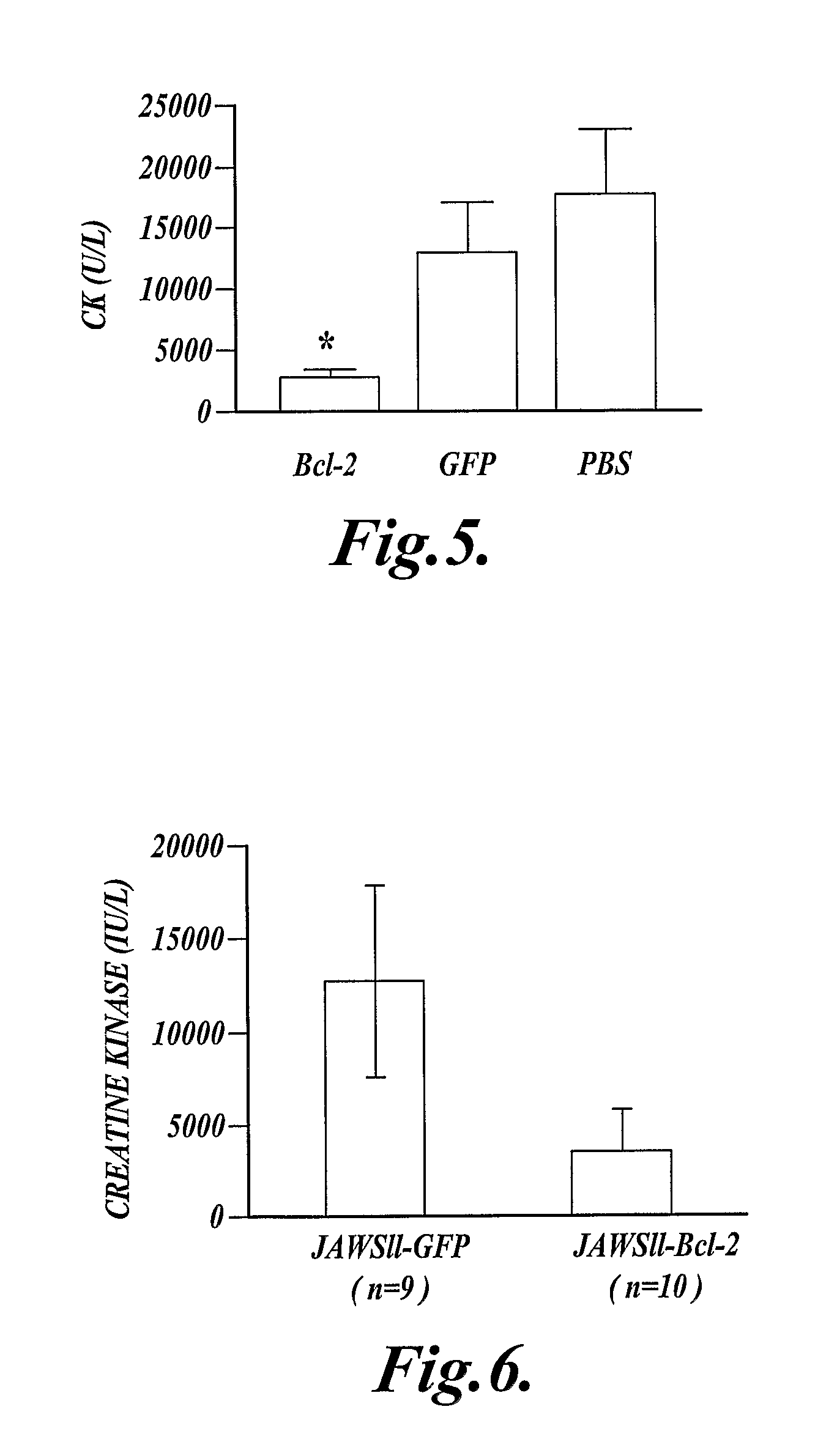Method of inhibiting inflammation in a mammal by administering Bcl protein
a technology of bcl protein and mammalian cells, which is applied in the field of exogenously administered proteins, can solve the problems of further affecting the health of injured or diseased organisms, cardiac muscle death, damage or killing living cells in mammal cells, and inhibiting cell death and/or inflammation. , to achieve the effect of preventing or delaying the onset of cell death, and inhibiting cell death and/or inflammation
- Summary
- Abstract
- Description
- Claims
- Application Information
AI Technical Summary
Benefits of technology
Problems solved by technology
Method used
Image
Examples
example 1
[0069]This Example describes expression of a cDNA (SEQ ID NO:13) that encodes the anti-apoptotic protein, human Bcl-2 (SEQ ID NO:14) in myeloid cells. Expression of the Bcl-2 protein (SEQ ID NO:14) in myeloid cells reduced injury following extended ischemia in the mouse hind limb.
[0070]Mice expressing a recombinant human Bcl-2 (SEQ ID NO:14) in their myeloid cells (hMRP8-myeloid-Bcl-2 mice), and control mice that did not express the recombinant human Bcl-2 (SEQ ID NO:14) in their myeloid cells were used in this experiment. The hMRP-myeloid-Bcl-2 mice were previously described by Lagasse, E., and I. L. Weissman, J. Exp. Med. 179:1047, 1994, which publication is incorporated herein by reference. These mice were on a C57BL / 6 background, and the control mice were C57BL / 6 mice.
[0071]Mouse skeletal muscle was made ischemic by cross-clamping the aorta distal to the renal artery for 90 minutes, then the clamp was removed and hind limb reperfusion continued for 3 hours. At the end of reperfu...
example 2
[0074]This example shows that over-expression of human Bcl-2 (SEQ ID NO:14) in T-lymphocytes reduces skeletal muscle injury following extended ischemia in the mouse hind limb.
[0075]Transgenic mice, on a C57BL / 6 genetic background, expressing exogenous human Bcl-2 (SEQ ID NO:14) in their T-cells under the control of the Eμ-promoter (EμT-Bcl-2 mice), and eight C57BL / 6 control mice that did not express exogenous Bcl-2 (SEQ ID NO:14) in their T-cells (C57BL / 6 mice) were used in this experiment. The EμT-Bcl-2 mice have been previously described and shown to express Bcl-2 (SEQ ID NO:14) only in T-lymphocytes (Strasser, A., et al., Cell 67:889, 1991, which publication is incorporated herein by reference).
[0076]Hind limb ischemia was induced by cross clamping the aorta as described in Example 1, and ischemia was maintained for 90 minutes followed by 3 hours of reperfusion. Blood samples were taken at the end of the experiment for determination of creatine kinase (CK) concentration in EμT-Bc...
example 3
[0077]This example shows that over-expression of Bcl-2 (SEQ ID NO:14) in leukocytes reduces DNA strand-breaks in skeletal muscle following extended ischemia and reperfusion of the hind limb.
[0078]Transgenic mice (described in Example 2) expressing exogenous human Bcl-2 (SEQ ID NO:14) in their T-cells under the control of the Eμ-promoter (EμT-Bcl-2 mice); transgenic mice expressing exogenous human Bcl-2 (SEQ ID NO:14) in their B-cells under the control of the Eμ-promoter (EμB-Bcl-2 mice) (reported in Strasser, A., Proc. Natl. Acad. Sci. 88:8661, 1991); transgenic mice (described in Example 1) expressing exogenous human Bcl-2 (SEQ ID NO:14) in their myeloid cells (hMRP8-myeloid-Bcl-2 mice); and control mice (C57BL / 6 mice) that did not express exogenous Bcl-2 (SEQ ID NO:14), were used in this experiment.
[0079]It is known that extended ischemia followed by reperfusion of skeletal muscle results in DNA strand-breaks, and that treatment with the caspase inhibitor z-VAD prevents the strand...
PUM
| Property | Measurement | Unit |
|---|---|---|
| time | aaaaa | aaaaa |
| size | aaaaa | aaaaa |
| concentration | aaaaa | aaaaa |
Abstract
Description
Claims
Application Information
 Login to View More
Login to View More - R&D
- Intellectual Property
- Life Sciences
- Materials
- Tech Scout
- Unparalleled Data Quality
- Higher Quality Content
- 60% Fewer Hallucinations
Browse by: Latest US Patents, China's latest patents, Technical Efficacy Thesaurus, Application Domain, Technology Topic, Popular Technical Reports.
© 2025 PatSnap. All rights reserved.Legal|Privacy policy|Modern Slavery Act Transparency Statement|Sitemap|About US| Contact US: help@patsnap.com



